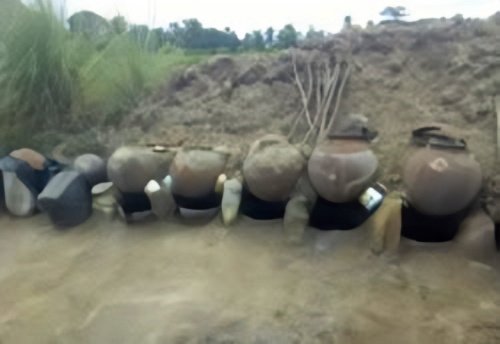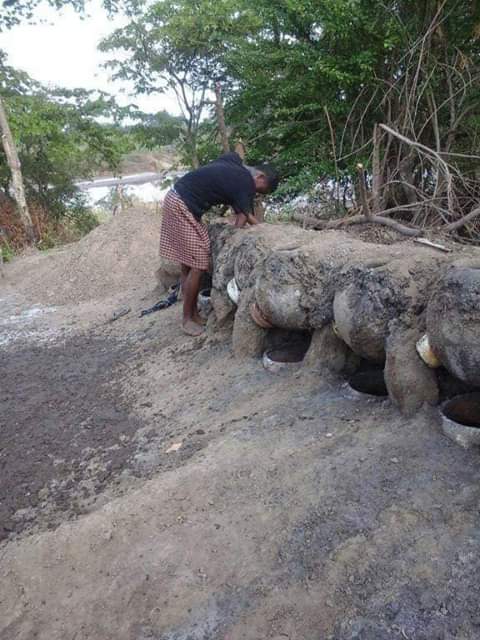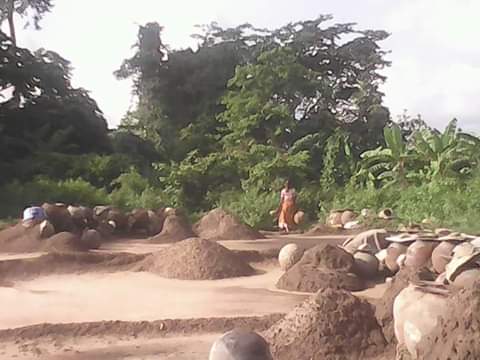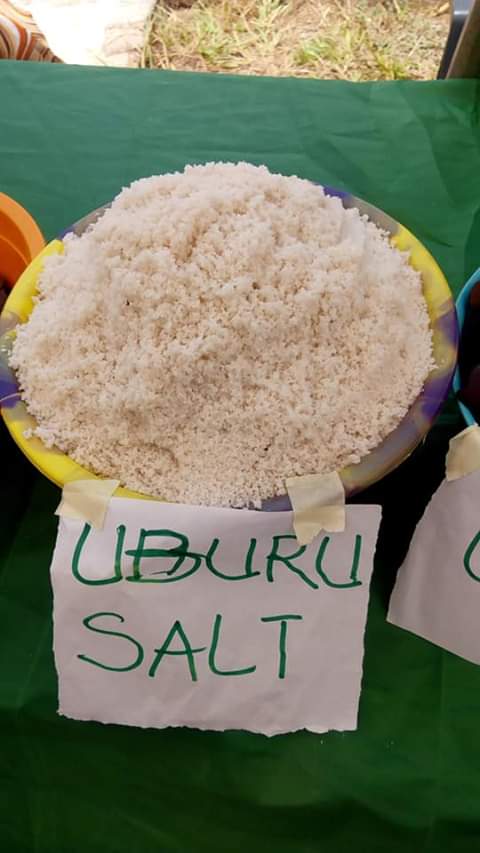The technology of Uburu salt making.
The story of women of Uburu in Ohaozara Local Government Area of Ebonyi State, is that of ingenuity and industry. It is the story of women, who, even in ancient times, created a technology with which they turned water into solid salt
A thread
The story of women of Uburu in Ohaozara Local Government Area of Ebonyi State, is that of ingenuity and industry. It is the story of women, who, even in ancient times, created a technology with which they turned water into solid salt
A thread
Indeed, they are women of uncommon strength and extraordinary initiatiative women whose efforts put to doubt the saying that women are weaker vessels, who depend on their husbands for survival. By their efforts, the community became known as o ji mmịrị akpa akụ.
And it is because of the salt feat that Ebonyi State is referred to as Salt of the Nation.
According to the Minister of Science and Technology, Dr. Ogbonnaya Onu, “the women of Uburu employed science and technology in salt making.
Indeed, Uburu is synonymous with salt making.
According to the Minister of Science and Technology, Dr. Ogbonnaya Onu, “the women of Uburu employed science and technology in salt making.
Indeed, Uburu is synonymous with salt making.
The history of the community cannot be complete without mentioning its salt, just as the Nile defines Egypt. Uburu is blessed with four salt lakes and the saline water is called mmahi.
In every material particular, the lakes are beautiful and inviting. The scenery is enchanting, like a patch of Eden.
“The process of salt production by Uburu women salt makers, using the local technology, is simple and interesting.
“The process of salt production by Uburu women salt makers, using the local technology, is simple and interesting.
It& #39;s a simple but awesome technology which has been handed down to generations for many centuries.
Right from the discovery of the lake till now, the process of salt making has been manual. By this method, the salt producers put in many days’ labour to produce just a small cone of salt.”
It was learnt that salt making was not an all-comers affair in Uburu. Although all married Uburu women or women married to Uburu men are free to partake in the salt making process, there are requirements to be met.
first of all,
first of all,
It was also learnt that she would be given a special haircut, even as women menstruating are not permitted to step into the lakes.
Offering insights into the process,
Offering insights into the process,
“For a start, the woman secures a piece of land (salt plot). She prepares it by leveling, after which she provides big earthen pots, which may be five or more depending on her ability. The pots are arranged in a straight line. The pots are supported with big stones, which raise
the pots completely from the ground. With wet clay soil, the stones are held together and in place. These large pots in a line are called by mmahi technical term, ofufu. Behind the ofufu is mounted another pot larger than ofufu. That larger pot is called Onini, which has a
different function from ofufu.”
“Underneath each ofufu is an earthen conical dish called nja ugbani. Each ofufu has a small perforation at the bottom. The nja ugbani is meant to collect the filtrate dripping through the small perforation at the bottom of the ofufu when the perforation is opened.
The opening of the perforation is called irufu eja. The larger pot behind the ofufu is meant for storing saline water to be used in ofufu when necessary. The salt plot, where the woman carries all these activities, is called onu ebe.
He also said: “On the appointed day, the new
He also said: “On the appointed day, the new
comer is given a special haircut, called ogo nwevi and led by a group of young women and girls from Ogwu and other villages to the salt lake. They decorate their bodies, sing, dance and walk gracefully in a line. In that mood, they carry saline water from the lake to inundate
every inch of the new comer’s salt plot in preparation for salt making.
“The actual production of salt starts with the collection of ‘earth’ from the water-bed of the lake using a flat metal called atakpa. The big pot (ofufu) is filled with earth until it gets to the brim. The
“The actual production of salt starts with the collection of ‘earth’ from the water-bed of the lake using a flat metal called atakpa. The big pot (ofufu) is filled with earth until it gets to the brim. The
top of the ofufu is carefully protected from rainwater. The water and the earth in the big pots (ofufu) are allowed to knead properly by leaving them over night with the small perforations at the bottom of the ofufu still blocked.
“In the morning, the perforations at the bottom of the ofufu are opened (irufu eja) to allow the filtrate to drain into the earthen conical dish beneath the ofufu-nja u gbani. The filtrate in the nja ugbani is collected and taken home for boiling to get salt. The collection of
the filtrate is carried on for a number of days until the maker collects enough to start boiling for salt.”
It was learnt that adequate preparations are usually made pursuant to boiling saline water (filtrate) from the nja ugbani referred to as ochichi. For instance, provisions
It was learnt that adequate preparations are usually made pursuant to boiling saline water (filtrate) from the nja ugbani referred to as ochichi. For instance, provisions
must have been made for firewood with which to start boiling ochichi, in a special big earthen pot called eju. However, in modern times, it was learnt, eju has given way to drums.
“When the boiling is on, the salt maker takes time to watch when salt starts to form in the eju
“When the boiling is on, the salt maker takes time to watch when salt starts to form in the eju
(drum). As it forms in the pot/drum, the maker gradually collects it and puts it into a small conical earthen dish called nja agba, so called because the dish is made at Agba near Abakaliki. It is in the nja agba that the salt is caked and made into sizes the owner wants.
This marks the final journey of the maker’s work. It is the final journey of the high level table salt produced in Uburu by local technology. The salt is then ready for domestic use or for the market,
The final product is always a sight to behold. Rock solid, it comes in various
The final product is always a sight to behold. Rock solid, it comes in various
sizes. And a little piece gives you the desired taste in a meal, which locals claim has medicinal properties.
In the 19th and 20th centuries, the Uburu salt market was booming. People came from far and near to buy the product, among other things such as gunpowder. “All sections
In the 19th and 20th centuries, the Uburu salt market was booming. People came from far and near to buy the product, among other things such as gunpowder. “All sections
of the Uburu community benefited and still benefit from the trade stimulated by salt. The women, in addition to selling the salt they produced, also sold food and drinks to visitors. The children supplied water to visitors, who paid them in cash. Also, the children helped the
visiting traders in conveying their wares to required places and earn money. In this way, the community got exposed to visitors, to commerce and to money economy much earlier than the communities around them. The interaction with wealthy visiting merchants and people of
different levels of sophistication brought benefits, which transcended the cash nexus because it also resulted in friendship, marriages and business partnerships, with attendant symbiotic advantages to both sides,”
It was the Uburu salt that sustained Biafra during the civil
It was the Uburu salt that sustained Biafra during the civil
war with Nigeria between 1967 and 1970 when the federal troops blocked essential materials from getting into the secessionist republic. One of the merchants, who took advantage of the influx of traders into Uburu to boost their business interest was Chief Odi Nsiri.
At a time when people were living in thatched houses, he built an edifice that commands respect even till today. It was also the influx of people into the community that made the Europeans to set up missionary activities in 1912.

 Read on Twitter
Read on Twitter












